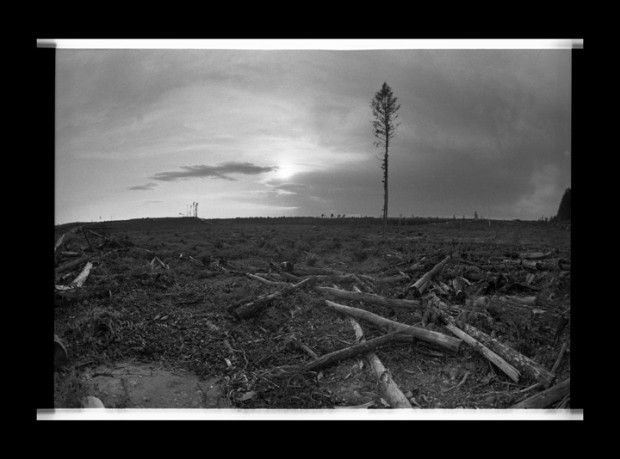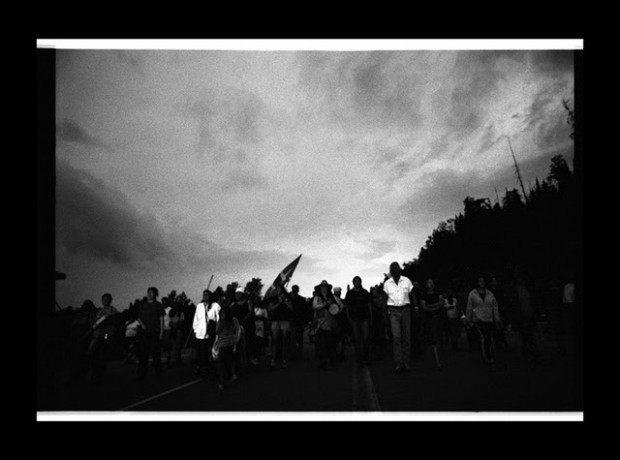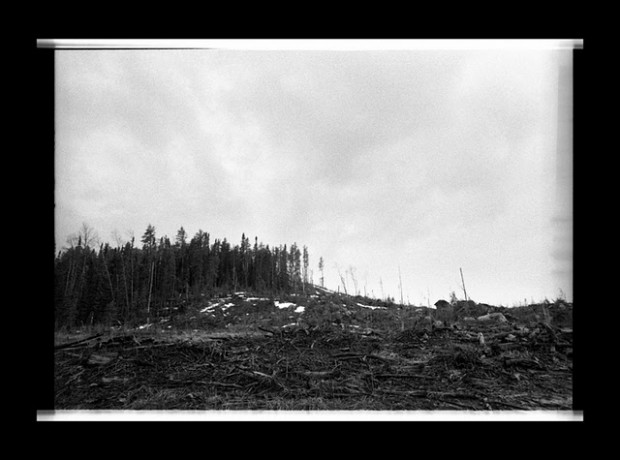How Grassy Narrows’ lawsuit could change aboriginal-government relations across Canada
Carmelle Wolfson@TeamCarmelle

Remnants of a clear cut logging operation near Grassy Narrows, Ontario. Photo by Jon Schledewitz.
On a cold December day nine years ago, a group of young people from the Grassy Narrows First Nation lay down in front of a line of logging trucks on a snow-covered road.
Chrissy Swain, now 32, recalls that day at Slant Lake, about an hour north of Kenora, Ontario, which set off what has become Canada’s longest-standing logging blockade. “Back then youth didn’t have a voice,” Swain says. “But people started taking us more seriously when we started the blockade.”
For a long time, Grassy Narrows was accustomed to not being heard. In the 1950s, new hydro dams flooded the low-lying river valleys the First Nation had lived in, driving away the fur-bearing animals and submerging wild rice beds and sacred spiritual sites. In the early 1960s, the Canadian federal government moved the small Grassy Narrows community away from the river to a new location on a small stagnant lake off the highway to Kenora, where Chrissy Swain and her friends grew up. The 1970s brought more devastating news: the nearby Dryden pulp and paper mill was pumping mercury into the water. It eradicated the local fishing industry, leaving the community poor and sick. Hunting and trapping came to replace fishing, but in the 1990s, the provincial government of Mike Harris opened the area to clear-cut logging, which quickly drove out moose and other animals on which the community relied.
Chrissy Swain’s grandfather was one of many people affected by mercury poisoning on the Grassy Narrows and White Dog reserves. Today he shakes uncontrollably and can barely walk. Swain was just 16 when she began to realize things weren’t as they should be in her community and decided to take action. Though Swain would share in spiritual ceremonies, pick wild berries, fish and hunt, she yearned for a traditional Anishinabe life of living off the land. “I lost out on that part of my identity,” she tells me.
Decades of neglect and abuse by two levels of government have left a grim legacy, in the form of joblessness, drug and alcohol abuse, and physical and sexual violence, all of which afflict Grassy Narrows still. But a number of factors have recently come together that offer hope. One of these is a recent legal decision that could protect the land from harmful industry activity that affects aboriginal hunting and trapping. The precedent doesn’t just herald an opportunity to regenerate a devastated natural environment—it has the potential to turn the entire relationship between Canada’s First Nations and federal government upside down.
Years of mercury poisoning and clear-cutting “put them into a corner where they had to take a serious stand on both those issues,” explains Treaty 3 Grand Chief Diane Kelly. Chief Kelly is the leader selected by national assembly to preside over the 140,000-square-kilometre treaty territory encompassing two First Nations in Manitoba and 26 in northwestern Ontario, including Grassy Narrows. She says Grassy Narrows is facing these challenges head on. “The people of Grassy Narrows have been really diligent in standing up for their rights.”
The way Chrissy Swain sees it, standing up for those rights is just part of providing for her children, like any working Canadian mother. She’s been bringing her three kids to demonstrations and blockades since they were babies. Since 2008, Swain has led annual walks to raise awareness about indigenous and environmental justice. The first was over 1,800 kilometres from Grassy Narrows to Toronto, ending in a “Sovereignty Sleepover” at Queen’s Park attended by hundreds of First Nations leaders and activists across Ontario. Her last walk took her to a sun dance in Manitoba. “It was only a 300 kilometre walk,” she says casually.
Over the years the community has used every tactic in the book to stop industrial clear-cut logging: roving blockades of logging roads and highways, boycotts, rallies, speaking tours, and a high-profile court case. In the last few years, this persistence has started to pay off. Forestry giant Abitibi-Bowater surrendered its forestry license in 2008 and large-scale clear-cuts have stopped for now. Domtar (the largest paper producer in North America) and Boise have also committed not to source wood from Grassy Narrows traditional territory. More recently, a major legal victory for the small reserve of 900 residents asserts aboriginal hunting and trapping rights override the Province’s right to resources in the Keewatin Lands, a 50,000 square kilometre area in the Boreal Forest.
Grassy Narrows trappers Joseph Fobister, Andrew Keewatin, and now-deceased Willie Keewatin brought the suit in 1999 to judicial review, leading to a case in the Ontario Superior Court. “It’s quite simple,” explains 55-year-old trapper Joseph Fobister. “My right to hunt and fish are protected by treaty. When clearcut logging happens, it takes away that right.” The judge awarded them legal costs before trial, saying the issue was in the public interest and hadn’t been considered in any previous case.
“We’re not against logging. We’re just against bad logging,” says trapper Fobister. In the ’60s, he says he had good rapport with loggers, often catching rides to his family trap-line with them. Now, “there’s nothing for me to trap.” When he was young, unmarketable trees and debris were left. Today it’s a different story. “Everything is gone when you go there now.”
After years of waiting, the reserve finally got the chance to present its evidence in nearly eight months of hearings. On August 16, 2011 Justice Mary-Anne Sanderson ruled in favour of Grassy Narrows in a lengthy 300-page judgment. Ontario cannot infringe on aboriginal rights to hunt and trap enshrined in the Treaty 3 agreement signed in 1873 with the federal government, the judge said.
Joseph Fobister was choking back tears when he heard the news. “My first thought was ‘justice at last.’ It’s been a long 10 years waiting for something to happen,” he tells me following a press conference at Queen’s Park. Grassy Narrows Band Council Chief Simon Fobister is also elated: “This time the Indians won.”

A protest by members of the Grassy Narrows First Nation. Photo by Jon Schledewitz.
Trapping isn’t the only concern over clear-cut logging. Research suggests clear-cut logging practices can increase mercury levels in the soil. This past September Chief Fobister led a Grassy Narrows delegation to Japan to raise awareness about the health effects of mercury. Mercury poisoning, called Minamata disease, was named after the Japanese city where the first case was observed, after chemical company Chisso dumped waste water into the local bay. While on a trip to Japan, Chief Fobister screened the film The Scars of Mercury, a documentary about the findings of Japanese doctor Masazumi Harada, a leading specialist in mercury poisoning. Harada has been closely studying the situation in Grassy Narrows since the ’70s. In 2010, following his fifth visit to the reserve, Dr. Harada reported the impacts of mercury poisoning are worse now, despite mercury levels having decreased. Today pregnant women are still passing this mercury to to their fetuses and babies are being born already suffering Minamata disease.
When I visited Grassy Narrows in 2006, clan mother Judy Da Silva drove me in the back of her pickup truck out to a clear-cut where she picked wild herbs and berries and hunted and trapped as a kid. A large expanse of dust and baby evergreen saplings now stands where the old mixed forest used to. Da Silva, a tireless activist, could often be found sitting near the fire at the Slant Lake blockade, while her children skipped rocks on the lake or explored the bush behind the log cabins. Now her daughter Taina, 17, is taking up the cause, giving a public talk for the first time at the Ontario Institute for Studies in Education while visiting Toronto this past summer. It’s the steadfast commitment of clan mothers like Judy Da Silva that continues to inspire the next generation of activists today.
“They have given a really strong foundation that has resulted in what we see today in this decision,” says Clayton Thomas-Muller. A tar sands campaigner with the Indigenous Environmental Network, Thomas-Muller grew up as a Mathais Colomb Cree in Winnipeg, joining the Native Youth Movement at 17 where he began working with Grassy Narrows.
Thomas-Muller says the case of Grassy Narrows represents a sophisticated new strategy: a collaboration between environmental and economic justice movements, NGOs, and indigenous solidarity groups across North America, using a variety of tactics, including civil disobedience, education campaigning, and legal challenges. “What Grassy [Narrows] represents is one of those catalyst moments in our contemporary history between Indian and white relations in this country.”
“Not only was it a decision for the people of Grassy, but it was a victory for all First Nations across Canada,” he says. Resource extraction industries have disproportionately affected the health and livelihoods of First Nations communities across the country. Whether it is the tar sands in Alberta that Thomas-Muller is now focused on fighting, or the mining, hydroelectric, or timber industries, native communities are on the front lines almost everywhere in Canada. Changing the calculus of how First Nations can control what industry can do on their lands is huge.
Robert Janes, the lawyer representing Grassy Narrows trappers, agrees that the decision has pretty big implications for First Nations across Canada. “This case doesn’t just apply to logging. It indirectly applies to all major resource development that could interfere with their treaty rights.” That includes mining, hydroelectric dams, transmission lines, and more. People in Grassy Narrows are hoping the court ruling will be a spark that ignites change across Ontario, says Janes, like the 1970s decision over hydro that led to the James Bay and Northern Quebec Agreement being signed with the Cree nation and the Quebec and federal governments.
“The courts have become more and more direct and prescriptive in their decisions because they too are becoming frustrated that the governments aren’t following certain court decisions,” says Russell Diabo, a First Nations policy consultant who has worked closely with the Algonquins of Barriere Lake in Quebec. “If that trend continues I think it’s going to become harder for the executive branches of the government to ignore.”

Forest near Grassy Narrows First Nation adjacent to a clear cut site. Photo by Jon Schledewitz.
The Ontario Ministry of Natural Resources has appealed the case to the Ontario Court of Appeal and Robert Janes says that the case will likely be appealed all the way to the Supreme Court of Canada. This could drag out the issue for another five years. Janes believes that the government wants to preserve the status quo with regards to logging, but the likelihood of reaching a negotiated solution, the desired outcome for Grassy Narrows, will depend on the newly elected provincial government.
After a long legacy of government decisions that negatively affected the community, including residential schools, hydro flooding, mercury poisoning, relocation, and now the destruction of their forests from clear-cut logging, it’s easy to see why people in Grassy Narrows are taking a wait-and-see approach.
Andrew Keewatin, who initiated the legal case over a decade ago, is also skeptical. “It will be interesting to see if they’ll honour the decision now,” he says. “Most likely they’ll try to find a way around it.” Keewatin, known as “Shoon” in Grassy Narrows, teaches traditional practices to the reserve’s young people, such as building log cabins, snowshoe making, fishing, and trapping. “Trapping is no longer a means of livelihood for people on the reserve. It’s more of a favourite pastime,” he says. Life on welfare has taught trappers to limit their activity to the reserve, he explains. But he is looking towards the future. He notes that the Trappers Council is looking into ways of selling furs directly to tourists and that some businesses in South Korea have shown some interest in buying their otter furs.
How will this court ruling affect people on the front lines in Grassy Narrows? “We’re still going to be here,” says Swain, insisting the blockade will persist even after the ruling. “I’m still going to stand up for my children,” she says. “I’m teaching them, too, so that after I go they can use their voice.” What does she think about the court ruling? “It’s not a victory yet,” says Swain, explaining it’s a step forward, but there’s still a lot more work to do.
As the logging blockade enters its 10th year, Grassy Narrows First Nation is continuing to assert its sovereignty. This fall, the activists started issuing a toll on the blockaded logging road—many Americans visit the Lake of the Woods area, a popular tourist camping destination, driving past the log cabins and wig-wams at the blockade. When it comes to plans for the future, Swain isn’t short of them. She suggests that instead of the government issuing licences to campers on their lands, Grassy Narrows could set up their own camps. She also hopes they could someday take over jurisdiction from the Ministry of Natural Resources, regulating poaching and other activities on their land to create their own jobs. She says change is slow, but she sees it happening. “We’re trying to take back everything that was taken from us.”